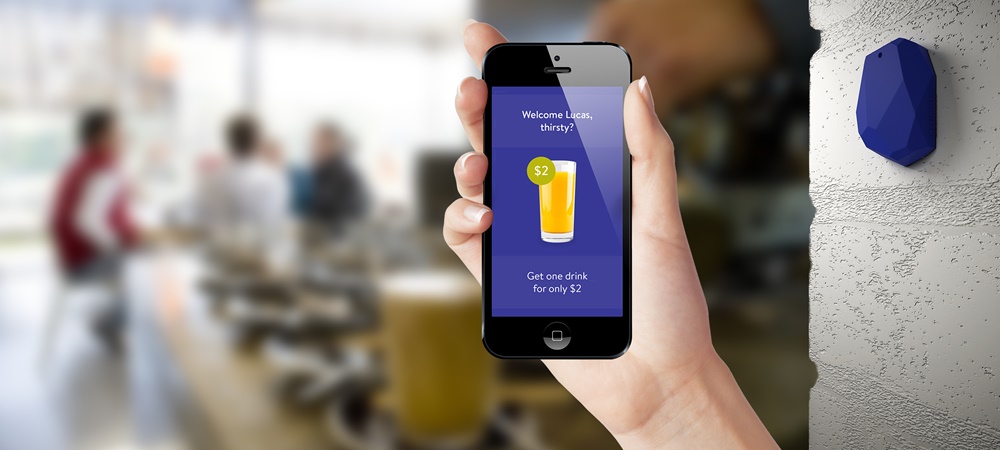Striving to remain competitive against the onslaught of online purchasing, bricks and mortar retailers are under increasing pressure to create dynamic shopping experiences to encourage customers back over their thresholds.
Fulfilling the desire to ‘have it now’ and encouraging impulse shopping is one way the retail industry can ensure sales.
Another is by offering shoppers individual customer experiences and tailored discounts by using beacon technology to detect where they are and what they are likely to want.
Beacons use Bluetooth low-energy (BLE) wireless and geo-fencing technology to ‘listen’ for a signal when a customer with a store app is within a specific range.
Importantly, the customer has to ‘opt in’ by downloading a company’s branded app onto their smartphone and enabling their location services to link location data with other customer information held by the organisation.
This increases the ability of companies to deliver a highly personalised experience, tailored to meet individual wants and needs, when it matters most. It also addresses all the permission and data privacy issues at the same time.
Fortunately, the popularity of mobile shopping apps is on the rise and the willingness of consumers (89 per cent) to share their data (provided they are rewarded in return) has seen about one-third of the top 100 US retailers already using beacons with 85 per cent of these retailers expected to deploy beacon technology by this year’s end.
Global brands have already started to embrace beacons with McDonalds recently running a proximity marketing study in Istanbul in which beacon-enabled promotions were offered to customers.
Across 15 restaurants, the company achieved a 20 per cent conversation rate, boosting awareness of a range of new products.
A huge variety of other businesses, ranging from hotels and sports stadia to retailers, could also create more dynamic interactions with their customers because they are more willing to engage with a brand when they are already in situ.
In addition, US research has revealed that four in five smartphone users would like search results to be customised to their location so ‘geo-targeting’ offers an opportunity for pay-per-click adverts to capture a much more receptive audience.
As well as the direct promotional angle, beacons provide a huge opportunity for marketers and researchers to take ‘in-the-moment’ feedback to the next level.
By combining location data with other sources of data, such as past behaviours or purchase history, brands can anticipate customers’ future needs and ask the right questions at the right time to better enable them to meet those needs.
The following are just a couple of the many potential uses of beacon technology.
1. A real-time view of the customer experience.
This is now a vital differentiator in many industries so it follows that location technology should be regarded as an integral part of customer experience (CX) and market research (MR) programs tasked with understanding key customer behaviour.
Asking customer questions while they’re onsite ensures their memories are fresh and enables businesses to act quickly to prevent negative word of mouth if necessary.
But customers don’t want to be bombarded with surveys every time they pop into a shopping centre, so the solution is to take data integration seriously.
It’s about correlating location-based data, including path to purchase or non-purchase and promotion conversion rates, with other rich sources of customer data, such as purchase patterns and demographics.
This enables businesses to identify and selectively trigger the ‘next step’ with individual customers, potentially at the very moment when they are making a decision to purchase.
2. The ability to perform ‘live’ A/B testing.
By correlating data about their customers, companies can use predictive analytics to understand likely future behaviour.
Location data then provides an insight into their actions at the point of purchase or non-purchase.
For example, if two recognised customers of a particular brand of coffee both enter a supermarket, they could be presented with two different promotional offers—20 per cent off for one and a free cup for the other.
Background data about those customers could determine which offer they receive, and a very short survey could help understand which has the biggest impact on their subsequent behaviour.
The powerful combination of predictive analytics, sample selection and personalisation of the marketing message provides two benefits: the customer receives the tailored experience they may now expect; and the organisation is able to pinpoint specific information to help them define the most effective promotions to use on a wider scale.
Insight teams looking to conduct deeper analysis of customer behaviour will clearly benefit from embracing the growing trend of customers communicating with brands via mobile devices and beacon technology.
Businesses must incorporate this instant form of feedback if they want to create relevant content, fine-tune processes and secure increased sales by tapping into this real-time, emotion-led feedback.
Combined with traditional research and integrated into key operational and financial systems, beacon technology really can expose a much improved customer experience.
Chris Breslin is the Australia and New Zealand manager of Confirmit, an international market research and voice of the customer solutions vendor.

